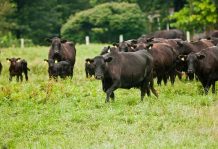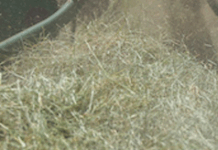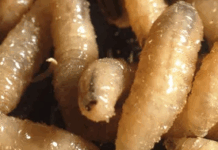As reported in High Plains journal, future marketing challenges and drought were two topics that dominated discussion among panelists who took part in the Aug. 5 Cattle U and Trade Show at United Wireless Arena, Dodge City, Kansas.
“Not necessarily, in my opinion, of the betterment (of the industry) but out of necessity,” Campbell said.
Smaller producers have been “steamrolled” by the large-chain process. “The COVID-19 pandemic in 2020 changed how consumers buy beef and opened new opportunities for small independent meat packers who have developed a niche,” he said.
“These small independent packers are still killing a lot and that is good thing,” Campbell said. “I’m not sure it will feed the masses.”
The concentration of the meat packing industry is still the dominant factor, he said, and makes it tougher on smaller marketers and ultimately impacts the farmer and rancher. who “cannot sell a hamburger one at a time.”
The end result remains troublesome and clouds the future, he said.
Kelli Payne, president of Oklahoma National Stockyards, Oklahoma City, Oklahoma, says pre-pandemic many producers were making all the right decisions and through the pandemic and post-pandemic they are continuing to make good decisions and in the future will continue to do so but there risks, too.
Corbitt Wall, commercial cattle manager for DV Auction and host of the Feeder Flash daily cattle marketing summary and based in Canyon, Texas, said his concern with vertical integration is that it’s a top-to-bottom model rather than a bottom-to-top process, which allows producers—regardless of size—to have an opportunity to profit.
He likened what he has seen to the change in the hog industry. He remembers when he worked at the U.S. Department of Agriculture in 2000, the feeder pig industry was still a viable market.
“They were just as excited as Kelli is selling a nice set of black baldies,” he said.
The problem at the current pace—without reform—is in 25 to 30 years he envisions a cattle industry that will be similar to the pork industry as smaller producers and backgrounders continue to feel the brunt of the cost squeeze.
“We don’t have enough negotiation now,” Witt said. “It scares me.”
Josh Mueller, a fourth-generation farmer and rancher from Halstead, Kansas, who along with his wife own El Dorado Livestock Auction, said producers also need to remember the business has a history of being cyclical. The pandemic caused a significant shift in consumer behavior and millennials are among those driving that shift.
In the 1980s and 1990s the focus of meat consumption was through fast food restaurants. Today many consumers consider themselves foodies, which means they are fans of meat and have a greater passion for it. Those positives can be built upon.
Another reason he is more optimistic is that packers do not want to own or raise cattle. It takes a lot of resources and land to raise cattle. Mueller said individuals who come to events, like Cattle U, and share their stories help the overall story that needs to be told.
“We need to come together and talk about,” he said of the marketing challenges, then quipped, “We are stubborn and bull-headed when it comes to cattle production.”
Drought concerns
Campbell said the drought has made it tough but he calls the 2002 one of the most devastating in its impact on producers’ long-term prospects. One difference is this year the market has prices that allow a producer to stay profitable.
Payne said the drought has been spotty and not as bad as it was seven to 10 years ago but there are producers who are selling more ahead of their original schedule. They are also starting to cull a little bit deeper into their herds. She worries it could get worse without more widespread moisture.
Wall said the northeast region of Texas and the region from Dallas to San Antonio have been hit the hardest and small producers are the ones who have really been hurt. “They are the bread and butter for sale barns,” he said.
Once those producers fully liquidate, those numbers will not come back. The liquidation level is high enough that Wall will not be surprised if in a couple of years the U.S. Department of Agriculture will no longer list Texas as the nation’s top cattle state.
Mueller said states that have been hit hard are really suffering but his region has been less impacted. “As far as cows coming to town early, I don’t see that.”
The Flint Hills and central Kansas have mostly been spared of the conditions of the western region; however, regardless of region, “everybody takes a turn at it,” he said. It is a reminder that producers need to always have a plan, regularly review it and be willing to act on it.
The experts said special sales can work to the sellers’ advantage, but they also noticed other trends too. Mueller said the seller might want to pay attention to the overall market in the week that leads up to the sale. He also says producers might want to make sure they match up with like-size cattle.
Wall said producers need to work closely with their marketing agent.
“You need to be best friends,” he said and quipped, “Drink coffee in the morning, tea in the afternoon and beer at night.”
The marketing agents are the key and it requires work on behalf of the seller. “Don’t just show up at the sale. If you have a nice set of cattle, let them know early.”
Payne said that 2 1/2 years ago Oklahoma National Stockyards partnered with Oklahoma Angus for special sales twice a year and that has been a success as Oklahoma Angus uses it as an opportunity to sell feedstock. Her team focuses on it each week. “Every sale is special,” Payne said.
Campbell said the overall market is the bigger factor and that is why he re-emphasized the importance of the producer and marketing representative relationship. A buyer from Nebraska won’t buy 30 head of cattle from La Junta because of cost of freight, but if he can combine several groups of cattle the buyer likes and can create a load there is an opportunity for the sellers to have an additional outlet.
Freight, fuel expenses
Freight prices were also on the minds of the marketers. Managers understand the cost of diesel, particularly on independent truckers, which are the primary carriers for their respective outlets, and it has pinched bottom lines. Wall said stories abound of truckers who give up their independent gig to take a six-figure salary to drive a truck for Walmart.
This all comes at a time when calves need to be hauled south from ranches in the northern Plains this fall. “The market is really good until they run out of trucks,” Wall said.
Payne works with truckers to find back hauls as a way to offset costs but that has become tougher. She has gained a greater appreciation for those truckers who continue to do it out of the love for the industry.
Campbell said the barns have to work closer with buyers to accommodate their trucks and at times that may mean feeding the cattle in the outlet’s pens additional days.
The panelists agreed that following protocols to keep cattle healthy should be a high priority. Wall said having a third-party verification on vaccines is gaining more popularity. Years ago, there was an assumption if cattle had a blackleg shot that met the definition of full inoculation but he added most pharmaceutical companies have a protocol that makes sense to follow.
Mueller said the increase in “all-natural beef” sales has added value—and responsibility—for producers to have third-party verification because buyers expect it. Mueller will not be surprised if that does not become a full market standard.
“Two shots are good and three rounds is almost better,” he said. If they are not weaned at least 45 days or preferably 60 days, the seller is unlikely to get a premium.
Payne also preferred 60 days but she noted if the producer needs to sell without the shot protocol, it maybe something he or she has to consider depending on the individual situation.
Although much of the focus is on getting top dollars for sellers, Campbell said to keep in mind what many marketers know when it comes to buyers.
“We don’t remember the good ones, but they remember the wrecks and the bad deals.”
Cattle U and Trade Show is an annual High Plains Journal event.




